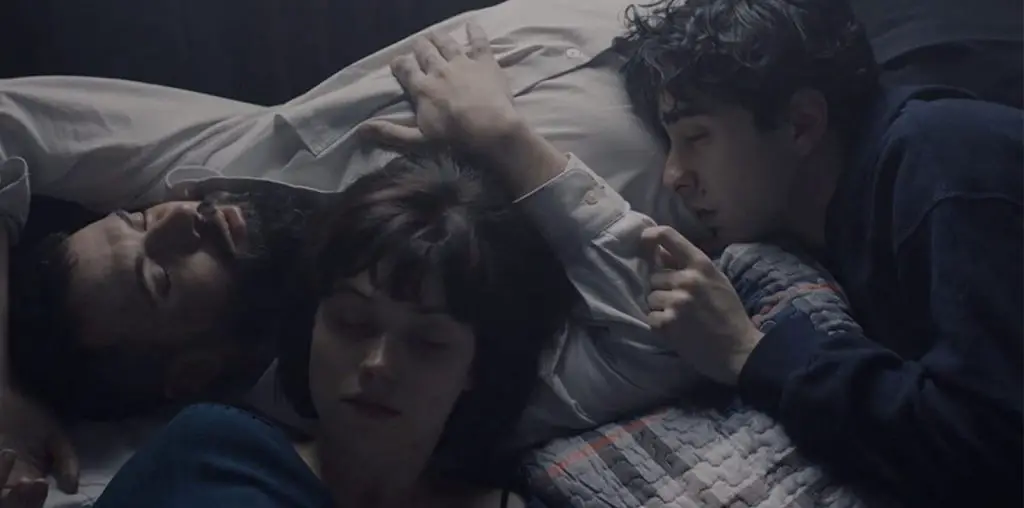
“The Signal” begins with a short clip of an extremely faithful recreation of a 70’s era Grindhouse film (It’s “The Hap Hapgood Story, directed by “Signal” co-director Jacob Gentry for you trivia buffs.), then it blurs and distorts into something alien. You can almost make out shapes in the flickering lights, as if something was alive in there. Thus are we introduced to the titular signal.
The TV that it’s playing on when we first see it belongs to Ben, with whom a married woman named Mya is having an affair. Both are sleeping at his place when the signal starts. In fact, the TV has actually turned itself on. Ben stumbles over to it and shuts it off. Now awake, Mya realizes she’s stayed over way too late and has to get back home immediately. The two have a tense conversation about where their relationship is going, with Ben saying that nothing is impossible. They could be together. She could leave her husband. They could go anywhere, they could go… (He picks a place at random) to the train station at terminal 13. They could leave and never come back.
Mya is touched, and almost convinced, but goes home anyway. It’s on the trip back that she slowly begins to notices that things are wrong. A homeless guy in front of her car has been attacked and is bleeding; another man comes at her babbling nonsense. When she arrives at her tower block you can hear screaming arguments in every single apartment. The mood can be best described as “eerie chaos”.
It isn’t long before things get really bad. Her husband Lewis and his friends are trying to watch a baseball game but all they can get is the signal and they’ve been exposed to it for God knows how long as they try to get the TV to show the game, then the screaming arguments from earlier start to degenerate into just screaming and it gets even worse from there. In the space of a few minutes several dead bodies litter the hallway and a man with garden shears is coming for Mya.
Everyone always says “The world’s a crazy place,” but what if it was literally true? What if the whole world did go crazy one night? “Signal” attempts to tell a tale of two lovers trying to find each other after everyone loses their mind and the entire planet turns into one giant free range insane asylum with no doctors or guards. The clever bit is that it’s told in three distinct parts, from three points of view; written and directed by three people:
Transmission 1: Crazy in Love
Transmission 2: The Jealousy Monster
Transmission 3: Escape from Terminus
What I was most impressed with was the consistency between all the stories. I couldn’t tell at all that this wasn’t the work of one person. I’m sure if I picked it apart I could find a few stylistic differences, but overall this is a true collective effort.
I’m also impressed by how the dialogue of the crazy people actually follows a perverse kind of logic. It’s not like in a lot of lesser films where the crazies are simply cackling loons who do things for no reason or because the script needs them to. The writers have gone through a lot of trouble to make it extremely hard to figure out who is crazy because of the signal and who’s simply crazed because of all the craziness. And because of the subtlety in almost every single scene, the acting has to be nothing less than excellent. Lucky for us, it is. “Signal” has some really prime performances by the leads. Scott Poythress, who plays a landlord named Clark, is particularly noteworthy. Poythress has to go from goofy to serious and back again in the same scene several times, yet not only does he have to make it look believable but he has to tie in all these conflicting moods into one cohesive personality.
If you’re tired of zombie films or rabid people films, “Signal” is like a cool drink of water on a hot day. It’s got all the goodness from the best of those genres while creating its own niche at the same time. “Signal” is its own thing. It doesn’t borrow and it doesn’t copy; and that, if nothing else, makes it worth a look.
